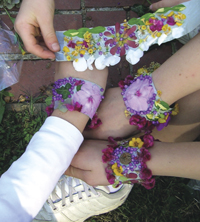Gardening
with
Kids
Story
by Paula Steers Brown, Contributing Columnist. Photos by Bill Sherrod.
|

A
fun and creative garden project is a "wearable harvest"
bracelet: blossoms and berries collected and artfully arranged on
the sticky side of duct tape. |
When school lets out for the summer,
children have time and boundless energy that can be channeled into a fun and
healthy hobby: gardening a pint-sized plot of their very own.
When I was little, my mother helped me
prepare the soil in a three-foot circle and gave me packets of easy-to-grow
seeds such as zinnia, marigold and nasturtium to plant. We christened it my
garden and every day I anxiously ran out to see what miraculous changes had
occurred.
Nature provides countless hours of
amazing entertainment for free. Wise parents will take advantage of it as
the best possible babysitter and teacher. Let kids get their hands dirty,
explore, experiment. For these few years of your child�s youth, try to be
not as concerned with aesthetic perfection in your landscape as with
promoting his or her interaction with the earth.
The best gardens for children are
interactive. Constantly in motion, kids love to run along paths. Stepping
stones or paved paths can provide a track for running and biking as well as
a canvas for sidewalk chalk art. If you are lucky enough to have ample yard
space for a grassy recreation area, consider letting it grow a little long
after a rain, then mow base paths for a softball diamond and call in the
neighborhood.
Paths can almost magically become
enticing tunnels if skyscraper perennials such as hollyhocks or sunflowers
shoot up on each side of a walk. A simple circle outline of shrubby plants
(after they get a little height to give a feeling of enclosure) becomes a
great hideout. A circle of boxwood we let grow to three feet became �The
Bat Cave� in our yard, the designated conference area of resident
Superheroes. A planted circle can take on the dimension of a puzzle if an
inside design is added to form a maze. Another shelter effect can be
achieved by tying angled stakes at the top to form a teepee, and planting at
each support a fast-growing vine such as bean, miniature pumpkin or gourd.
Weeping trees also give a sense of
secret enclosure, but almost any large tree with low branches for climbing
is a kid magnet. Magnolia trees look their best when they skirt the ground;
leaving their close-together limbs intact down low creates an accessible
living ladder. A tree house can be the hub of outdoor recreation, but even a
simple swing suspended from a sturdy limb brings hours of pleasure and stirs
a welcome breeze in hot summer. Nestle evergreen ferns around a wide swing
in a freestanding frame to anchor this focal point in the cool shade. Turn a
garden shed into a playhouse for a few years. Children grow up so fast that,
all too soon, you will get back your space.
Animals in any form make great garden
additions. A rabbit hutch in the center of the garden has storybook charm,
but also provides eco-minded parents a way to show children that manure is
practical and highly prized over chemical fertilizers. A shallow pond or
creek brings endless fascination as a home for fish, tadpoles, frogs and
turtles. A re-circulating pump can be installed into a slope of rocks to
give a creek-like effect. Along with the standard birdhouse or feeder, place
a birdbath in the garden so children can fill their feathered friends�
swimming pool with water when they fill their own.
Cosmos grows easily from seed to attract
goldfinches. It and other open-faced flowers such as daisies and coreopsis
attract ladybugs � the good
bugs that eat the bad bugs (aphids and mites). Buddleia is a must for
drawing in butterflies; include also brightly colored Asclepias (butterfly
weed), a great food source for monarch caterpillars. Earthworms not only
interest children for their squirminess � they provide a terrific science
lesson as the best soil builders anywhere. They aerate by burrowing and
their castings enrich the earth with nitrogen, phosphates and potassium as
they digest and deposit valuable elements. Ladybugs and redworms can be
purchased online and added in quantity to start benefiting the garden.
Sensory elements add an interactive
quality to the garden. Wooly lambs� ears, pussy willow, and grasses with
soft catkins lend tactile sensations. Visually, kids respond to bright
colors and unusual shapes in the garden � grow giant alliums, which look
like Paul Bunyan�s purple lollipops. In fact, unusual sizes of flowers or
fruits get plenty of attention, be they mini or mammoth.
Taste tests of harvests are
ever-popular, so grow cherry tomatoes and popcorn. Sample aromas of herbs
such as mint, sage or rosemary and use for cooking; grow aloe vera to
demonstrate plants as practical first-aid ointment. Since kids love
surprises, plant a few surprise lily bulbs (Lycoris squamigera), pink
beauties that pop up overnight in August. Really, any unexpected bulb is
fun, especially snowdrops and crocus, which sometimes poke their heads out
so early it is through snow.
Morning glories, four-o�clocks and
moonflower are fun to tell time by. Chinese lantern (Physalis) is great to
grow for its showy red-orange paper lantern shapes. They are almost too
pretty to tear open, but do open one to show a child the surprise orange
�light bulb� inside. Money plant (Lunaria) is interesting for little
hands to open, too; rub the tissue-thin filmy discs off to expose seeds and
the silvery �coin� inside. The harvest affords gorgeous materials for
crafts as well as free seeds for next year�s small miracles.
� Paula Brown is a freelance writer
and lecturer on gardening topics. She lives in Richmond, Va., where she runs
her design business, Imagine That.